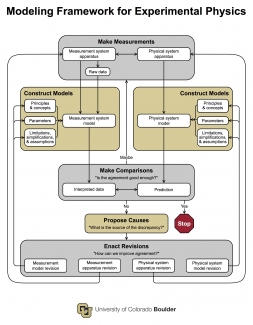The Experimental Modeling Framework (EMF) is one way to describe the nonlinear, recursive process through which experimental physicists develop, use, and refine models and apparatus. In the context of upper-division physics lab courses, we developed the EMF to characterize students' model-based reasoning and to inform the development of instructional lab environments that engage students in the practice of modeling. A diagram of the EMF is shown at left, and a pdf is available for download below.
Click here to download a pdf of the EMF.
Models and Modeling
Models are abstract representations of the real world. A well-defined model is associated with a target system or phenomenon of interest, and can be used for either explanatory and/or predictive purposes. Importantly, models contain simplifying assumptions that yield tractable mathematical, graphical, and other representations. These assumptions limit the applicability of a model. Moreover, model limitations give rise to the possibility of model refinement by eliminating some assumptions. The iterative improvement of models to make them more accurate and sophisticated is one path in the process of modeling.
Modeling is the process through which models and systems are brought into better agreement, either by refining the model or the target system itself. The EMF divides the target system into two parts, each with its own corresponding model: the physical system and the measurement system. This division reflects the fact that experimental physicists often operate measurement equipment in regimes where the limitations of that equipment become important.
Why is the Experimental Modeling Framework Important?
The EMF is connected to national and local learning goals for undergraduate physics laboratory courses. At the national level, the American Association of Physics Teachers identifies modeling as a major focus area for learning outcomes for lab courses. Similarly, on a local scale, modeling was identified as an important learning goal by instructors in the CU Boulder Department of Physics. The EMF was designed, in part, to support instructors in thinking about how to engage students in the practice of modeling, both nationally and here at CU Boulder. In addition to informing the design and/or transformation of laboratory courses, the EMF provides physics education researchers with a tool for characterizing and assessing students’ performance in experimental physics activities.
Applications of the Experimental Modeling Framework
Our initial applications of the EMF have focused on electronics and optics courses and activities. At CU Boulder, we have transformed the Electronics Lab and the Advanced Lab courses, typically taken by physics majors during their third and fourth year of instruction, respectively. In addition, we have demonstrated that there is a good mapping between the EMF and students’ process of completing optics and electronics activities. Specifically, we have used the framework to describe students' approaches to using a photodetector to characterize the power output of an LED and their approaches to repairing a malfunctioning cascade amplifier circuit. We have also used the EMF as a tool to prompt student reflection and investigate students' views about the process of experimental physics.
Ongoing work is focused on: (a) development of assessments that instructors can use to measure growth in students’ ability to use model-based reasoning to complete experimental physics tasks, and (b) investigation of the extent to which students engage in modeling in advanced lab open-ended projects.



 The Physics Frontiers Centers (PFC) program supports university-based centers and institutes where the collective efforts of a larger group of individuals can enable transformational advances in the most promising research areas. The program is designed to foster major breakthroughs at the intellectual frontiers of physics by providing needed resources such as combinations of talents, skills, disciplines, and/or specialized infrastructure, not usually available to individual investigators or small groups, in an environment in which the collective efforts of the larger group can be shown to be seminal to promoting significant progress in the science and the education of students. PFCs also include creative, substantive activities aimed at enhancing education, broadening participation of traditionally underrepresented groups, and outreach to the scientific community and general public.
The Physics Frontiers Centers (PFC) program supports university-based centers and institutes where the collective efforts of a larger group of individuals can enable transformational advances in the most promising research areas. The program is designed to foster major breakthroughs at the intellectual frontiers of physics by providing needed resources such as combinations of talents, skills, disciplines, and/or specialized infrastructure, not usually available to individual investigators or small groups, in an environment in which the collective efforts of the larger group can be shown to be seminal to promoting significant progress in the science and the education of students. PFCs also include creative, substantive activities aimed at enhancing education, broadening participation of traditionally underrepresented groups, and outreach to the scientific community and general public.